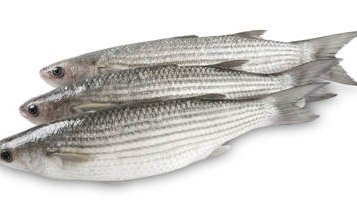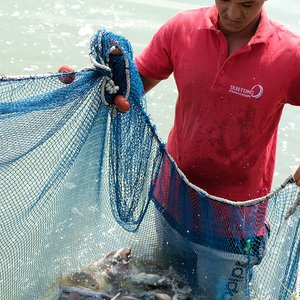In captive grey mullet (Mugil cephalus) juveniles, the weaning stage overlaps the period where there are changes in the ontogeny of digestive enzymes as the fry transit from carnivory to omnivory.
To improve the knowledge on grey mullet weaning, an international group of researchers evaluated the growth, survival, weight distribution and the activity of pancreatic and brush border digestive enzymes when fry are fed a carnivorous, herbivorous or omnivorous weaning diet.
Fifteen 17-L aquaria in a flow through system with 40‰, UV treated, temperature (24.5 ± 0.5 °C) controlled seawater were stocked with eighty-five 23 dph grey mullet larvae per aquarium. Three weaning dietary treatments were tested differing in their protein and carbohydrate content in 5 replicate aquaria per treatment from 24 to 53 dph. Diet 1 was the dried macroalgal species Ulva lactuca and was designated as a low protein (high carbohydrate herbivorous diet). Diet 2 was a commercial microencapsulated starter feed designated as a high protein (low carbohydrate carnivorous diet). Diet 3 was a 1:1 mixture of diets 1 and diet 2 representing an omnivorous feeding regime.
Results showed that the final weight of the omnivorous feeding fish was higher than carnivorous and herbivorous ones. The population of fish fed the herbivorous diet showed higher percentage of smaller fish than the omnivorous and carnivorous feeding fish.
Pancreatic α-amylase, alkaline protease and trypsin activity significantly rose when dietary carbohydrate increased, whereas chymotrypsin and lipase activities were independent of the type of diet. The activity levels of brush border alkaline phosphatase and intracellular leucine alanine peptidase were similar in grey mullet fry fed the carnivorous and omnivorous diets, but were higher than those in fish fed the herbivorous diet. The intestinal maturation index exhibited the highest and lowest values in mullet fry fed the carnivorous and herbivorous diets, respectively, whereas those from the omnivorous group showed intermediate values.
Researchers suggest that aquaculture feeds for juvenile grey mullet should be designed for omnivorous feeding habits.
Find the research study here.













